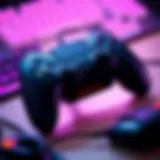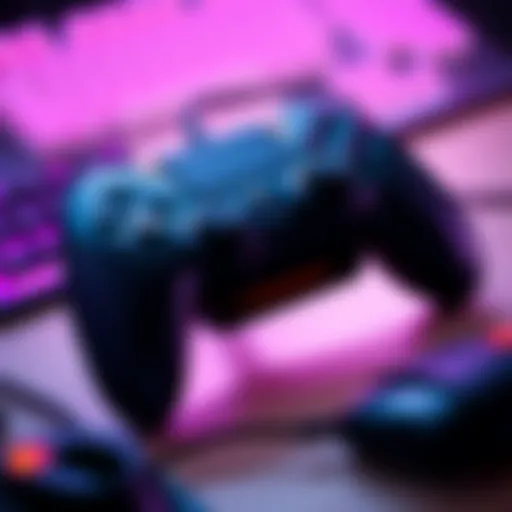Exploring Invincible Season 2: Comic Roots and Impact
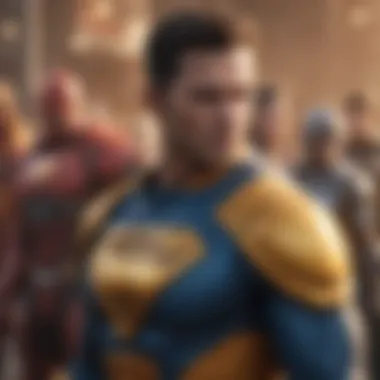

Intro
The anticipation surrounding Invincible Season 2 has reached a fever pitch. As dedicated fans and curious newcomers alike eagerly await the next chapter of this critically acclaimed animated series, it becomes essential to examine its roots. The show's complex characters, elaborate plots, and profound themes don't exist in a vacuum; they stem from the rich universe crafted in the original comic series penned by Robert Kirkman.
Understanding this connection—the lifeblood of the adaptation—provides valuable insights into how the animated version not only adheres to its source material but often reshapes it. In this article, we will dissect character developments, thematic depth, and the impressive artistic influences that elevate the series. Let’s take a closer look at how the storytelling in the animation intertwines with the comics, enhancing the experience for viewers.
Furthermore, this exploration will touch on how audiences have reacted to the new season, as well as the critical perspectives that accompany it. As we delve deeper into the lore of Invincible, we’ll arm you with context that enriches your viewing experience. It's a treasure trove of knowledge waiting to be uncovered.
Understanding Invincible
In the realm of modern animated adaptations, 'Invincible' stands out as a notable case study. This series is not merely a kaleidoscope of action and adventure; it delves deep into complex themes and character arcs that resonate well beyond the comic book pages. Understanding 'Invincible' is crucial for any fan or newcomer eager to explore the rich tapestry of narrative that shapes not just Season 2, but the entire franchise. The series intertwines superhero antics with raw human emotions, examining what it truly means to be heroic in a world filled with moral gray areas.
This section aims to shed light on the franchise, particularly its roots and evolution, offering a lens through which to appreciate the layered content that unfolds in both the comics and the animated series.
Overview of the Franchise
'Invincible' is the brainchild of writer Robert Kirkman, renowned for his work on 'The Walking Dead.' Launched in 2003, the series quickly gained traction for its unique take on the superhero genre. It chronicles the journey of Mark Grayson, a teenager destined to follow in the footsteps of his powerful father, Omni-Man. Yet, unlike other superhero narratives, it embraces a more grounded reality, where the stakes are high, and the outcomes are often unpredictable.
The franchise has expanded beyond its comic book origins into a successful animated series on Amazon Prime Video, drawing in a broader audience. The combination of gritty storytelling, combined with vibrant artwork, creates a compelling narrative that keeps fans on the edge of their seats. It's not just about superpowers and battles; it's about family, relationships, and the burdens that come with responsibility.
Origins of the Comic Series
The 'Invincible' comic series began its journey in 2003 under the banner of Image Comics. From the outset, it distinguished itself through its approach to the superhero genre, blending classic comic tropes with refreshing originality. The narrative is filled with poignant moments that stick with readers long after they've turned the last page.
Mark Grayson’s character serves as the heart of the story. The origins of the comic reveal a young man grappling with expectations, personal struggles, and the challenge of being the son of an almost god-like figure. Readers witness a poignant evolution as Mark transitions from a regular teenager to a reluctant hero.
In a world filled with superhero tales, 'Invincible' stands out because it asks questions that are relevant to our everyday lives: What does it mean to have power? How do personal choices impact the greater good? How does one reconcile their dual identities?
"'Invincible' is more than an account of superhuman feats; it's a reflection of the human condition, skillfully wrapped in a superhero narrative."
Through its compelling storytelling and unique characters, 'Invincible' digs beneath the surface, offering readers and viewers alike a tantalizing glimpse into a world where heroes are flawed, and decisions can have devastating consequences. As we transition into the animated series with Season 2, understanding these origins becomes paramount. It enables fans to appreciate the nuances brought to life on screen, giving context to the choices characters make and the stakes they face.
The Transition to Animation
The shift from a comic book to an animated series is not just a simple transformation; it's a reimagining of narrative depth and visual storytelling. This transition plays a crucial role in how audiences perceive and interact with the Invincible universe. It allows for the expansion of characters and plotlines, which could sometimes feel constrained within the pages of a comic. Here, the animated adaptation serves multiple purposes: it engages old fans while beckoning new audiences and provides a fresh canvas for storytelling.
In this context, the significance of the animation lies in its ability to present dynamic visuals and emotional depth that ink and paper alone can’t convey.
From Page to Screen
Adapting Invincible from comic to screen means more than just drawings coming to life. It requires understanding the essence of the original material while crafting a narrative that resonates in a different medium. One of the first steps in this process is deciding which story arcs and character developments hold the most weight, both emotionally and narratively. For example, significant events from the comics, like Mark Grayson’s evolution into Invincible, lay the groundwork for rich storytelling.
Additionally, dialogue adaptation becomes crucial. Some lines in comics have a comedic tone that might not translate perfectly to the screen. In animation, timing and delivery can enhance or undermine a moment’s impact. Therefore, the writers must balance originality with the existing script to maintain the comic's flavor while ensuring the animated dialogue flows naturally.
"An adaptation is not simply about retelling a story; it's about breathing life into it, allowing it to explore new dimensions."
Animation Style and Techniques
The visual representation of Invincible is paramount in conveying its themes and tone. The animation style deliberately mirrors the comic’s vibrant aesthetic while bringing a more fluidity and depth, contributing to the overall viewing experience. For instance, the incorporation of 3D rendering techniques alongside traditional 2D animation enhances movement and action scenes, providing a more immersive atmosphere for viewers.
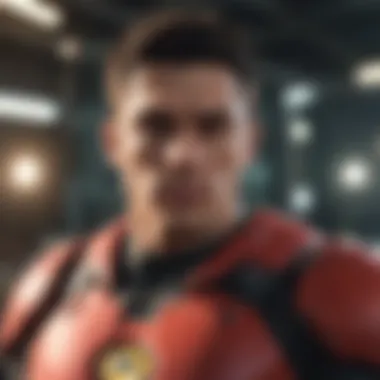

Moreover, these techniques can highlight emotional moments; close-ups of facial expressions and subtle movements add layers that the static nature of a comic cannot achieve. Color palettes play a critical role here as well. Bright, bold colors symbolize heroism and optimism, countering the deeper, darker moments of the narrative.
In summary, the transition from page to screen is about much more than merely animating panels. It requires a thoughtful approach that balances respect for the source material with innovative storytelling techniques — a challenge that makes the Invincible adaptation a noteworthy topic in the realm of animated series.
Character Analysis in Season
Understanding character analysis within the context of Season 2 of Invincible is pivotal. Characters are more than just shapes on a page or screen; they embody the complexities of human experience, moral dilemmas, and the essence of storytelling. In this season, we anticipate a deeper exploration of personalities, their struggles, and the maturation process they undergo. The burrows into their depths reveal how challenges mold them, setting the stage for growth and dramatic tension.
Mark Grayson: Growth and Challenges
Mark Grayson, the protagonist, exhibits tremendous development throughout this season. Initially introduced as a somewhat naive teenager, he faces trials that test his limits in this season. With his dual identity as Invincible and Mark, viewers witness a more nuanced portrayal of his struggles, particularly how he reconciles the responsibilities of heroism with the typical trials of youth.
- Growth: Mark’s journey embodies the classic hero’s arc, but it’s tinged with personal stakes. His relationships with friends and family add layers to his character. For instance, the relational dynamics with his father, Omni-Man, take new turns, challenging Mark to assert his independence while grappling with feelings of betrayal.
- Challenges: Season 2 presents Mark with formidable foes, not just physical adversaries but also emotional battles. His internal conflict revolves around understanding his place in a world that expects so much from him. This complexity is what makes him relatable and compelling.
Supporting Characters and Their Evolution
Supporting characters in Invincible are not mere sidekicks; they serve as catalysts for Mark’s growth while facing their individual journeys. Season 2 delves into the intricacies of their arcs, showcasing how their evolution complements the primary narrative.
- Amber: As Mark’s love interest, she plays a critical role in showing how personal relationships can influence decision-making. Amber's resilience and independence raise the stakes for Mark to step up not just as a hero but as a partner.
- Robot: The character of Robot offers a fascinating take on humanity and identity. His transformation and struggles with autonomy highlight a broader theme of what it means to be human, especially juxtaposed against his mechanical nature.
- Duplicity of Relationships: Other characters, such as the Guardians of the Globe, face their dilemmas, leading them to shift alliances and complicate the dynamics within the team. This adds depth to the storyline as it demonstrates how miscommunication can lead to chaos among allies.
Villains: A Deeper Look
The villains in Invincible serve as mirrors to the heroes; their motives illuminate the complexities of moral choices. The second season promises to flesh out these characters, providing context behind their misdeeds.
- The Immortal: The predicament of The Immortal poses interesting questions about mortality and power. His ability to come back from death raises dilemmas about sacrifice, purpose, and the nature of revenge.
- Beyond Stereotypes: The portrayal of villains in this season tends to stray from one-dimensional evil. Each antagonist has backstory and motivation that complicates the audience's perception, fostering an understanding of their motives while keeping the tension alive.
"Understanding villains is just as important as grasping a hero's journey, as both are intrinsically tied to the narrative’s heartbeat."
This multifaceted character analysis not only enriches the plot but also resonates on a deeper level with viewers, allowing them to invest emotionally in the narrative. By shedding light on the development of both heroes and villains, Invincible Season 2 encapsulates the essence of storytelling—revealing our own struggles and triumphs through the lens of extraordinary beings.
Story Arcs: What to Expect
In the ever-evolving narrative of Invincible Season 2, understanding the story arcs becomes crucial for both seasoned fans and newcomers. The arcs are not merely tangled threads of plot; they serve as the backbone that holds the entire narrative together. These arcs shape character development, propel the action forward, and deepen the thematic resonance of the series. As we delve into this section, we will explore why these story arcs matter and what viewers can anticipate as the season unfolds.
Key Plot Points and Developments
To navigate through Invincible Season 2, one must acknowledge some pivotal plot points that are set to take center stage.
Here are few developments worth noting:
- Mark’s Moral Dilemmas: As Mark Grayson grapples with his dual identity as a student and a superhero, he faces choices that weigh heavily on his conscience. The line between right and wrong blurs as threats both external and internal emerge.
- Alliances and Betrayals: Expect some unexpected alliances. Characters who seemed steadfast may betray one another, strengthening the unpredictability of the show.
- Expansion of the Viltrumite Saga: The complexities of the Viltrumite culture will deepen. More characters from this heritage will appear, bringing new challenges and histories into play.
A deeper look into these key moments can provide insights into how they interlace with previous narratives, offering layers of meaning and indicating how character arcs might evolve throughout the season.
Integrating Comic Storylines
Invincible Season 2 stands as a testament to its comic roots. Integrating storylines from the comics not only enriches the viewing experience but also connects the dots for those familiar with the source material.
- Canon Events: Season 2 looks to adapt crucial comic arcs. For instance, the tension between Mark and his father is drawn from significant moments in the comics, which places the emotional weight on their relationship under the spotlight.
- Harmonizing Original Content with Canon: While the series revels in its comic origins, it also introduces original content that complements the established storylines. This blend allows for fresh developments while respecting the core essence of the comics.
- Character Development: It is essential to observe how prominent comic arcs influence current character development. For instance, look for how interactions with lesser-known characters from the comics could shift the existing dynamics between the main protagonists.
By bridging comic book narratives with animated storytelling, Invincible Season 2 not only honors its heritage but also explores new creative avenues, leading to a richer and multifaceted narrative experience.
“Story arcs are not merely events; they are the sinews of storytelling that intertwine character and theme.”
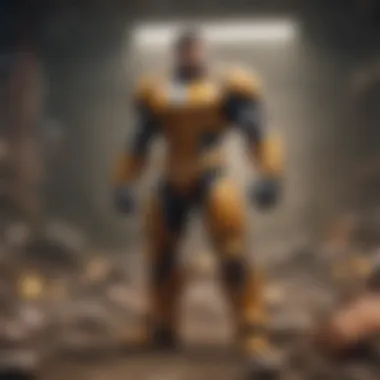

In exploring these aspects, fans and critics alike can appreciate how carefully constructed these arcs are, reflecting a deeper understanding of narrative depth and character evolution. As we sift through the web of storylines, the anticipation of emotional payoffs and thrilling reveals remains at the heart of what makes Invincible Season 2 a compelling watch.
Thematic Elements of Season
The thematic elements in Invincible Season 2 play a crucial role in shaping not just the narrative, but also the character development and audience experience. This season advances the storytelling toward a deeper examination of intricate motifs like identity and responsibility, as well as the very nature of heroism itself. These elements make the show more than mere entertainment; they present a mirror through which viewers can explore difficult questions relevant to their own lives.
Identity and Responsibility
In Season 2, the exploration of identity is layered and multifaceted. Mark Grayson, the titular character, faces increasing pressure as he oscillates between his roles as a son, a friend, and a hero. This internal conflict resonates deeply with the audience, especially those navigating similar transitions in their lives. Mark's journey portrays the struggle to define oneself amid external expectations, which adds a poignant dimension to his character arc.
The theme of responsibility is intertwined with identity. Each episode propels Mark into situations where he must make difficult choices, impacting not just his own life but those around him. The emotional weight of his decisions often leads to grim consequences, echoing the broader theme of the burden that comes with power. The asking of questions, like "What does it really mean to protect those you love?" becomes central in the storyline. It's a stark look at how one's actions can ripple through the lives of others, enticing viewers to reflect on their own responsibilities, both personal and societal.
"Identity is not just who you are; it’s what your choices make of you."
The Nature of Heroism
Heroism in Invincible Season 2 transcends the classic archetype of a superhero saving the day. Instead, it delves into what it means to be a hero in a world fraught with moral ambiguity. The season showcases how real courage sometimes stems from vulnerability—acknowledging limitations and seeking help when needed. Characters are pushed to their limits, and the lines between good and evil often blur.
By challenging traditional notions of heroism, the series sparks a conversation on ethical dilemmas faced by individuals in their daily lives, underscoring that heroism is not simply an act of valor but a continuous journey of personal growth and sacrifice. As different characters grapple with their definitions of heroism, viewers witness a spectrum of choices that lead to various outcomes, reinforcing that being heroic often involves navigating complex moral landscapes.
As expectations fluctuate, viewers are left to ponder:
- Is a hero someone who always succeeds?
- Can failures strip someone of their hero status?
The reflections presented through these thematic elements culminate in a richer narrative tapestry, drawing in tech-savvy individuals, gaming enthusiasts, and movie lovers alike, inviting them to engage thoughtfully with the material.
In sum, the thematic elements of identity, responsibility, and heroism not only enrich the narrative of Invincible Season 2 but also serve as important cultural touchpoints, encouraging viewers to reflect on their own lives and societal roles.
Visual Representation and Artistic Choices
Visual representation and artistic choices play a vital role in the world of animation, particularly for series like Invincible. It shapes not just the aesthetic appeal but also influences how the narrative resonates with audiences. In this section, we will explore specific elements of the show's art style and color palettes, revealing the impact of these choices on storytelling and viewer engagement.
Art Style Analysis
The art style of Invincible is a reflection of its origin from comic books, yet it brings a fresh twist that caters to modern sensibilities. This adaptation maintains the bold lines and distinctive character designs that fans recognize from the comics, while also adding a layer of depth that animation allows. This combination serves several purposes:
- Dynamic Action Sequences: The fluidity of animation enhances action scenes, bringing a sense of urgency and excitement that static comics cannot replicate. For instance, the fight scenes are designed to be visually impactful, presenting characters like Mark Grayson and his foes in a way that showcases their powers effectively.
- Character Expression: Animation allows for nuances in expressions that can convey emotions much more vividly than in print. Viewers can read the characters’ moods through their animated reactions, fostering a deeper connection with the storyline.
- Cohesive World-Building: The art style contributes to the world-building aspect of Invincible. By effectively utilizing backgrounds, character designs, and animations, it creates an immersive environment that enhances the viewer's experience.
Color Palettes and Their Significance
The color palette of Invincible plays a crucial role in emphasizing themes and emotions within the series. The creators have made thoughtful choices regarding colors, which affect the tone and mood of scenes. Here are a few significant aspects:
- Mood Setting: Bright colors might be used in scenes depicting hope and heroism, while darker shades can signify danger or despair. This tonal shift mirrors the emotional landscape the characters navigate, allowing audiences to feel the stakes involved,
- Character Distinction: Different colors also help viewers easily identify characters and their allegiances, making it clearer who’s who in the midst of complex plotlines. For example, Mark Grayson's iconic suit features vibrant colors that give off a youthful energy contrasted against the more muted tones of his enemies.
- Thematic Reinforcements: The colors often signify thematic elements like morality and power dynamics. For instance, scenes involving the Viltrumites utilize a stark color contrast to highlight their superiority, creating a visual cue that enhances narrative tension.
"Color is the keyboard, the eyes are the harmonies, the soul is the piano with many strings." – Wassily Kandinsky
In summary, both the art style and color palettes in Invincible Season 2 serve as crucial tools that enhance storytelling, deepen character exploration, and attract viewers. They are not merely decorative; rather, they are integral to conveying complex emotions and narrative developments that resonate with the audience.
Audience Reception and Critical Feedback
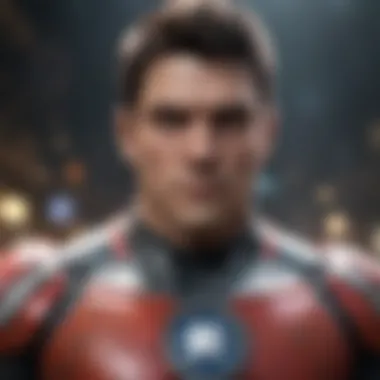

Understanding how viewers respond to a series is crucial for gauging its impact and success. In the case of Invincible Season 2, audience reception and critical feedback shed light on how effectively the series carries the comic's legacy forward while adding new layers to familiar narratives. Engaging with audience sentiments not only reveals emotional connections but also highlights gaps where expectations might not be met. This section emphasizes the importance of both viewer ratings and critical reviews in shaping the trajectory of the series, influencing future seasons and the underlying comic narrative as a whole.
Viewer Ratings and Reviews
Viewer ratings for Invincible Season 2 provide an immediate measure of triumph or trial; they indicate how well the series resonates with its audience. According to various platforms like Rotten Tomatoes and IMDb, Season 2 has garnered attention and mixed reviews, mirroring the complexity of its characters and plot arcs. Here are some factors at play in determining ratings:
- Character Development: Fans' enthusiasm for character evolution, especially for Mark Grayson, is often reflected in ratings. They appreciate deeper insights into his dilemmas as he juggles responsibilities of being a hero and a son.
- Story Arc Fluidity: Viewers are keen on how seamlessly the show integrates the original comic arcs into a cohesive narrative. Inconsistent pacing can lead to lower ratings, while engaging storytelling that balances action with emotional depth earns higher scores.
- Animation Quality: The quality of animation might not seem like a core element, but it plays a pivotal role in audience retention. Many viewers noted the impressive art style transitioning from comic to screen.
Overall, the blend of aspects leads to divergent opinions that shape the ratings in real-time. Keeping an eye on platforms for changes can be enlightening.
Comparative Analysis with Season
When audiences weigh Season 2 against the first season, numerous elements emerge, demonstrating not only how characters have progressed but also how storytelling techniques may have adjusted.
- Pacing: Many viewers felt that Season 1 had a more restrained pacing compared to the current season's frenetic tempo. Season 2 ups the stakes quite quickly, leading to contrasting opinions on how well such changes serve the narrative.
- Tone and Direction: Season 1 established a strong foundation that mixes humor and drama effectively. Season 2 takes bolder risks, leaning more into darker themes. Critics have noted that this tone shift can either alienate some viewers or profoundly resonate with those looking for depth.
- Character Focus: One clear difference identified is the shift in character focus. While Season 1 laid much groundwork for Mark, Season 2 spreads its wings to cover supporting characters more ambitiously, illuminating the complexities of their roles.
Future Directions: What Lies Ahead?
As we gaze at the horizon of Invincible Season 2, it beckons not merely as a continuation but as a springboard into uncharted territory. The comic series lays a robust groundwork, yet the animated adaptation has room to maneuver. This section sheds light on pivotal elements that may shape the future of this franchise.
Potential Character Arcs
When we think about character development, it’s much like watching a tree grow. Each season can introduce new branches, perhaps even some unexpected twists. One character that stands out is Mark Grayson, our protagonist. In the comics, particularly in arcs like "The Viltrumite War", Mark's struggle between duty and personal life intensifies. There’s potential for the showrunners to explore this inner conflict in a richer way. Perhaps they could introduce more layers to relationships with supporting characters, like Adam Eve.
- Exploration of Relationships: Dovetailing on the complex interactions with his friends and family could yield gripping dynamics, especially since these relationships define superhero narratives.
- Alien Parentage: Delving deeper into Mark's dichotomy as a Viltrumite and a human could pave the way for emotional turmoil that resonates with viewers.
Besides Mark, other characters like Omni-Man could have fascinating arcs. Given his ambiguous nature, the evolvement of his villainy is ripe for exploration.
Further down the line, characters like Dupli-Kate and Robot might also see more screen time, as their unique abilities and backstories could add depth to the storyline. If approached thoughtfully, such arcs would not only enthrall existing fans but also attract new viewers eager for substantial storytelling.
Expanding the Universe
One of the most exciting prospects in Season 2 is the chance to expand the Invincible Universe. Fans are already familiar with how the comics include a vast multiverse with various heroes and even villains. This could become a treasure trove of narratives for the series.
- New Characters: New heroes and anti-heroes from the comics could be peppered into the storyline. For instance, integrating characters like The Immortal, who offers rich history and complex dynamics, can create nuanced engagements that the audience would relish.
- Alternate Realities: With the Marvel and DC universes dabbling in multiverse storytelling lately, Invincible could take a page from this playbook. Bringing in alternate versions of familiar characters would not only spice up the narrative but also keeps long-time comic readers on their toes.
As the story unfolds, it’s essential for the writers to strike a balance between exploring new material while respecting the existing canon. By doing so, they create a tapestry that is ever-expanding, merging the familiarity of the original comics with the refreshing nuance of animation.
"A great series thrives on the intricacies of its universe, inviting fans to dive deeper into its realms."
Navigating these potential directions holds the key to keeping the material fresh and engaging. Whether it’s character growth or universe expansion, the future of Invincible promises to be anything but dull.
Concluding Thoughts
In wrapping up our exploration of Invincible Season 2 and its ties to the comic origins, it’s crucial to emphasize the duality of adaptation. Understanding how the animated series has carved its own path while paying homage to the source material is key. The intricate evolution of characters like Mark Grayson not only showcases their growth but also reflects broader themes of identity and responsibility, fundamental to both the comics and the series.
Moreover, the thematic depth present in this season highlights the nuances of heroism—the kind of heroism that’s fraught with challenges, sacrifices, and hard choices. Viewers are not simply passive observers; they are engaged in a dialogue with the material, drawing parallels between the lives of characters on-screen and the real world.
"Characters are not just figures in a story; they are reflections of our innermost struggles and aspirations."
The artistry involved in the animation and storytelling allows for a richer narrative experience, one that resonates deeply with audiences. By analyzing the artistic choices made in adapting the comic's vibrant palette and distinctive style, we uncover a layer of appreciation for the visual storytelling.
The feedback from audiences, marked by their ratings and reviews, further illustrates the season's impact. It sheds light on what fans value in a faithful adaptation and what innovations can be embraced. This dynamic interplay between expectation and creative expression fosters a more robust community around Invincible.
While contemplating the future of the Invincible universe, it becomes evident that the groundwork laid out in this season opens avenues for extensive storytelling opportunities. The hints at character arcs and potential expansions unveil a universe brimming with possibilities, inviting fans to engage in speculation and theories.
Overall, the significance of these concluding thoughts lies in recognizing the layered storytelling and evolving character dynamics as the core of what makes Invincible Season 2 undeniably compelling. As both an adaptation and a standalone narrative, it invites us to reflect on our interpretations of heroism, morality, and the gray areas in between.




